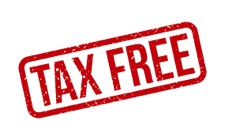 In 2022, 21 states issued special relief payments to eligible residents in 2022. The Tax Foundation has a partial list of state rebate checks.
In 2022, 21 states issued special relief payments to eligible residents in 2022. The Tax Foundation has a partial list of state rebate checks.
But do these state relief checks count as taxable income at the federal level? After taking a bit to think about it, the IRS has issued official guidance on how to account for these payments while filing your federal income taxes. Please see the full details there, but here is a quick summary below. For most people, the payments will not be taxable.
Filers in the following 17 states do NOT need to report “general welfare and disaster relief payments” from their state on their 2022 tax return:
- Alaska*
- California
- Colorado
- Connecticut
- Delaware
- Florida
- Hawaii
- Idaho
- Illinois*
- Indiana
- Maine
- New Jersey
- New Mexico
- New York*
- Oregon
- Pennsylvania
- Rhode Island
For individuals in the remaining 4 states listed below, state payments will not be included for federal tax purposes if the payment is a refund of state taxes paid and either the recipient claimed the standard deduction or itemized their deductions but did not receive a tax benefit.
- Georgia
- Massachusetts
- South Carolina
- Virginia
(* For Alaska, this applies only for the supplemental Energy Relief Payment received in addition to the annual Permanent Fund Dividend. Illinois and New York issued multiple payments and in each case one of the payments was a refund of taxes, which should be treated as noted above, and one of the payments is in the category of disaster relief payment.)
For example, in California, residents who received a California Middle Class Tax Refund (MCTR) of $600 or more received a 1099-MISC form. I am not a tax advisor, but based on this IRS guidance, you should not have to report this income on your federal taxes. If you already filed, you may need to file an amended return.
 The Best Credit Card Bonus Offers – 2025
The Best Credit Card Bonus Offers – 2025 Big List of Free Stocks from Brokerage Apps
Big List of Free Stocks from Brokerage Apps Best Interest Rates on Cash - 2025
Best Interest Rates on Cash - 2025 Free Credit Scores x 3 + Free Credit Monitoring
Free Credit Scores x 3 + Free Credit Monitoring Best No Fee 0% APR Balance Transfer Offers
Best No Fee 0% APR Balance Transfer Offers Little-Known Cellular Data Plans That Can Save Big Money
Little-Known Cellular Data Plans That Can Save Big Money How To Haggle Your Cable or Direct TV Bill
How To Haggle Your Cable or Direct TV Bill Big List of Free Consumer Data Reports (Credit, Rent, Work)
Big List of Free Consumer Data Reports (Credit, Rent, Work)
Speak Your Mind